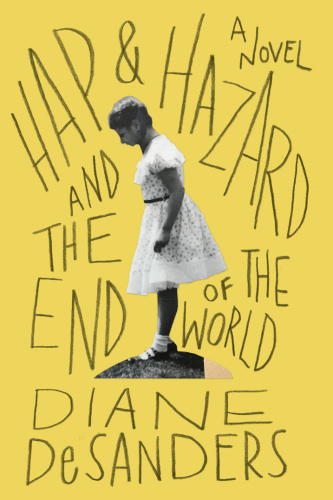
Hap and Hazard and the End of the World
کتاب های مرتبط
- اطلاعات
- نقد و بررسی
- دیدگاه کاربران
نقد و بررسی

October 15, 2017
A child yearning for answers to adult mysteries comes of age in this debut novel about post-World War II Texas. DeSanders' unnamed child narrator misses the attention she got from her mother when her father was away at war. He returned home, and two babies promptly arrived; she is displaced from the center of her mother's life. Her father believes in American institutions, traditional family roles. "Daddy believes in General Motors," she tells us, and "he wants to have things a certain way." The author captures the veneer of simplicity that followed the second world war. Capitalism, family, and country reign, but DeSanders' narrator wants to know why. What is truth? Is it built on trust? The author approaches these questions through the eyes of a child who wants to know everything, from the truth about Santa to how the universe works. "It seems like the main thing grown-ups want is for you not to find out anything about what's real," she laments. Unfortunately, her father suffers from PTSD and war injuries; his rage keeps his family on edge. The narrator's world becomes about trying to anticipate the outbursts of a deeply troubled man while helping her mother maintain the fiction of stability. "I decided then to at least go ahead and like Daddy," she tells us after he is in a giving mood, "on a trial basis." As the novel progresses, her view of the world eventually becomes predictably more shaded. "There is a change in the universe...," she says after an altering experience. "The world is plain and flat now, more gray, the mystery and the brilliance gone out of it." While it rings true, the novel's childlike narration may be off-putting to some readers. Readers who can look past that will find a time capsule of American awakening.
COPYRIGHT(2017) Kirkus Reviews, ALL RIGHTS RESERVED.

November 20, 2017
DeSanders gives readers a glimpse of postwar America through the eyes of a curious and thoughtful girl in her smart and subtle debut. The unnamed preteen narrator lives in suburban Dallas and is stuck between childhood, like her younger sisters (her parents’ clear favorites, if you ask her), and the adult world, which she is left out of and often doesn’t understand. She relates a mix of lighthearted experiences—an almost mythical appearance by the Easter Bunny, family dinner shenanigans, and her father’s intense passion for cars—and foreboding currents of darkness, as with the looming fear of nuclear annihilation and her father’s violent temper. The question of Santa comes up throughout, and the narrator’s changing thoughts on the possibility of his existence mark her growth toward adulthood. Although the narrator comes to life as she works through the problems of young adulthood—learning about God, stealing for the first time, seeing her mother age—it is the depiction of suburban life and the changes that swept through America after WWII that bring the book to life. While more of a set of interconnecting sketches than a single narrative, DeSander’s book offers a modest but moving example of a family trying to make life work.

November 15, 2017
DEBUT The narrator of this captivating debut novel gives a heartfelt view of growing up in post-World War II Texas with parents Dick and Jane, two younger sisters, and an extended family. Traumatized by the war, her father alternates between fits of rage and patiently showing her what is in the Book of Knowledge. Jane's role is to placate Dick so he won't get angry, and her parents are too preoccupied to help her through the mysteries of life. Is Santa Claus real? How did the three wise men know about the star? Yet Dick provides for his family as partner in the family car dealership, the Lone Star Oldsmobile and Cadillac; they have a maid and belong to the country club, and stylish Jane leads a privileged social life. The summer Dick has a breakdown, cousin Oliver gets too friendly and tragedy strikes both the dog Hap and his mate, Hazzy, in a major turning point in the family's lives. VERDICT Drawing on her own family letters, diaries, and oral histories, newcomer DeSanders captures the voice and thoughts of a young girl observing her frayed family while questioning the mysterious larger world. A brave and honest work that won't disappoint.--Donna Bettencourt, Mesa Cty. P.L., Grand Junction, CO
Copyright 2017 Library Journal, LLC Used with permission.

November 1, 2017
DeSanders sets her debut novel in Dallas, Texas, just after the end of WWII. The precocious, six-year-old narrator, who is never named, has to adjust to the return of her father, who fought in the war, as well as the subsequent arrival of two younger sisters. Her father's reintegration into the family is far from smooth: his feet, injured in the war, constantly pain him, and he flies into rages that are both frightening and frequent. Her mercurial father seems to respond more favorably to her middle sister, Annie, so the narrator wonders if her many quirks are to blame. After seeing the movie Miracle on 34th Street, she starts to fixate on the question of whether or not there's a Santa Claus. Her other fixation is on Oliver, her grandparents' brooding, adopted teenage son, an obsession that turns tragic. More a collection of linked vignettes than a fully formed novel, DeSanders' first outing paints a vivid picture of childhood in postwar America, replete with all of the joys and sorrows that are part of growing up.(Reprinted with permission of Booklist, copyright 2017, American Library Association.)

























دیدگاه کاربران